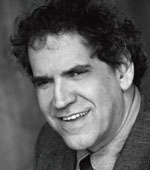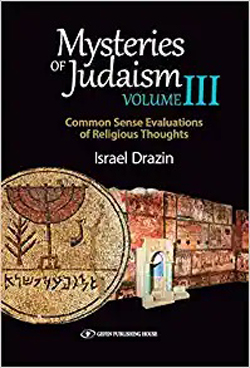How Judaism evolved over the centuries
Mysteries of Judaism III Common Sense Evaluations of Religious Thoughts by Rabbi Dr. Israel Drazin; Gefen Publishing, House, 2019; ISBN 96570-23106, 301 pages.
By Rabbi Dr. Michael Leo Samuel

 CHULA VISTA, California — After reading Rabbi Drazin’s newest book, Mysteries of Judaism III Common Sense Evaluations of Religious Thoughts, I thought about a lesson I once gave at my synagogue.
CHULA VISTA, California — After reading Rabbi Drazin’s newest book, Mysteries of Judaism III Common Sense Evaluations of Religious Thoughts, I thought about a lesson I once gave at my synagogue.
Imagine being a time-traveler. Your next destination is First Century Jerusalem. The purpose of your visit to the past is to discover how people observed Judaism about the time when the Temple was destroyed by Romans. If you took that trip, you might be surprised to find out that there were many sects of Judaism at that time. Here is a small sampling what you might find:
· Pharisees, the ancestors of Orthodox Judaism; the term “Pharisee” literally means “separatists,” or “pietists.” Their main belief is creating “fences” around the Torah, and indeed they certainly have over the centuries!
· The Sadducees, represented the priesthood and the Judaism of their time was Priestly Judaism.
· Essenes: Essenes adopted a cynical view of the Temple, which was controlled by the Sadducees; they also considered the Pharisees to be like “Reform” Jews of their times.
· Zealots: Jewish political revolutionaries are nothing new. The Zealots inspired the revolt against Rome, and their unsuccessful revolution died with them, along with the loss of the Temple and the Jewish statehood.
Rabbi Drazin’s newest book sets out to prove that the Judaism that everyone observes today is a relatively later historical development. Judaism continues to undergo endlessly new permutations. This observation applies no less to Conservative, Reform, Reconstructionist, Renewal, even some of the vestigial practices of so-called “secular Jews,” which to a certain degree follow variations of rabbinical Judaism. Yet, as the author noted, “The term Orthodox did not exist before the 19th century” (p. 175).
In his chapter on the prophet Micah (pp. 30-38), Rabbi Drazin argues that Micah was “unfamiliar with the Torah.” Nowhere does he criticize the people for not observing the Sabbath or the holidays. What he does criticize is the nation’s moral foibles and their indifference to the exploitation of the poor and other marginal sectors of ancient Israelite society. Micah is universalistic in asserting that non-Israelites will someday participate on the Mountain of the Lord (Micah 4:2).
He further points out that the oracular device used by the High Priest, known as the “Urim and Thummim” did not exist until the reign of King Josiah. This is quite remarkable that it never appears in the early prophetical books. Drazin contends that 1 Samuel 28:6, may be scribal insertion.
Rabbi Drazin goes so far as to question whether the early post-Israelite polity knew anything about Moses’ Torah, or even the enslavement of the Israelites in Egypt. Incidentally, Professor Richard Elliot Friedman contends only the Levites were enslaved in Egypt, while the rest of the Israelites never left Canaan. These ideas are certainly “heretical” from an Orthodox or even Conservative perspective, but academic scholars pose questions that will make us think.
One of my favorite chapters is where the author raises the question: Is the Zohar a forgery? R. Drazin points out how many pagan ideas found expression in Jewish mystical teachings. Most notably, R. Yaakov Emden (1697-1776) considered the Zohar to be a forgery. The existence of many Spanish words found in the synagogue reflect an early medieval origin—and it is highly unlikely a 2nd century rabbi would be speaking in a medieval Spanish lingo.
At times, I am amazed at Rabbi Drazin’s willingness to challenge the Orthodox community (of which he is a member) to re-envision how they view Jewish traditions.
Rabbi Drazin mentioned the 19th century Jewish philosopher Nachman Krochmal (1785-1840) was an example of an Orthodox Jewish thinker who thought “outside the box,” and contends that the midrashic stories mentioned in the Talmud should never be interpreted literally—a view that Ramban held. In his opinion, the Sages never imagined in their wildest dreams their stories would be interpreted literally! He further admitted that many of the laws found in Jewish tradition prove how these laws evolved over time. Krochmal always stressed the primacy of reason when it came to explaining how Judaism assumed the form it presently has.
In another challenging chapter, Rabbi Drazin wonders whether the biblical Joseph might have been “autistic” (pp. 39-42). Young Joseph’s inability to “read social cues, understand and anticipate the feelings of others” makes us wonder whether Joseph might have grappled with this life challenge. Whether one agrees with this interpretation or not, Rabbi Drazin’s desire to make his readers think is very challenging, as it is stimulating—even if one does not agree with this premise.
In another section on biblical obscurities, Rabbi Drazin points out that one of the important features of the Bible is that it is a book that leaves much to the imagination. This part is certainly true, and I would add that questioning the biblical text will yield more truth and insight than merely accepting its message at face value. The beauty of the “Oral Torah” is that the ancient rabbis rejected the notion of biblical literalism and in many instances, inverted biblical passages (e.g., eye for an eye,”) to yield a more humane text. Citing Shadal (Shmuel David Luzzato-1800-1865), he argued that rabbinical laws are called “biblical” because they believed what they enacted was in the “spirit” of the Torah.
With regard to Maimonides, Rabbi Drazin argues that Maimonides wrote for two types of audiences—the masses, as well for his elite group of scholars. Maimonides, he argues, did not believe that the soul survives the human body. Yet, he did believe that the individual’s intellect (or consciousness?) could survive a post-mortem existence—a view that Spinoza also advocated. Significantly, Maimonides did not personally believe in bodily resurrection, though he taught in his Thirteen Principles of Faith that resurrection is one of Judaism’s most important beliefs because he was speaking to the masses (p. 247).
In another chapter, Rabbi Drazin discusses the question: “Does the Bible Contain Humor?” In this section he discusses how the biblical writers frequently praise Solomon in one breath, only to lampoon him for his many excesses, e.g., his penchant for women from idolatrous backgrounds. This kind of humor is sardonic—especially when considering the great status King Solomon had. If you think a thousand wives is a bit too much, the old Chinese Emperor of the Forbidden City used to have 3000 wives.
We wonder: Did Solomon or the Emperor knew the wives’ names?
On the subject of humor, if I could make a suggestion to Rabbi Drazin to consider using in his next book, the name Abraham and Sarah illustrate how the biblical writers utilized pun in the text. Abraham was formerly “Avram,” while “Sarah” was formerly “Sarai.” To become the parents of Isaac, a name that literally means “he will laugh,” Avram and Sarai must change their names. Thus, Avram becomes “AvraHam” and Sarai becomes “SaraH.” The letter “Hai,” phonetically makes an “Ha” sound, when fused together, both their new letters signify laughter, as in “HAH, HAH!” To become the parents of Isaac, both Abram and Sarai must re-embrace laughter in their lives. This is, of course, a brilliant pun!
One of the most interesting short chapters deals with how Maimonides would have interacted with Buddhist ethical teachings. The question is an important one, but if Maimonides taught we must accept the truth no matter where it comes, this could apply to other faith systems such as Buddhism as well.
Mysteries of Judaism contains thirty-eight short chapters that deal with a different holiday, practice, ritual or belief and how these features of rabbinic Judaism differ from anything commanded in the Torah. It is the kind of book anyone reading can go through one section a day. More importantly, it is an excellent book to discuss with synagogue or church groups (if you happen to be Christian).
*
Rabbi Dr. Michael Leo Samuel is spiritual leader of Temple Beth Shalom in Chula Vista. He may be contacted via michael.samuel@sdjewishworld.com